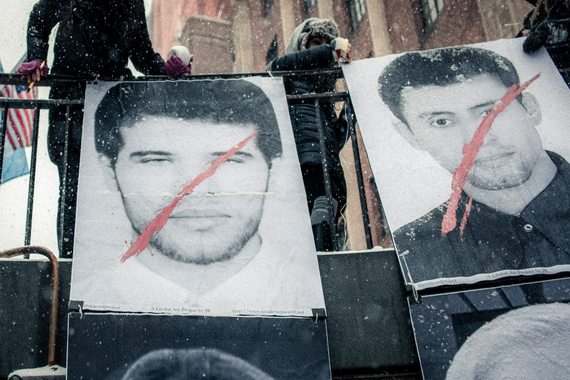One night last month, the flashing lights and sounds of a mass rush of emails, texts and social hits woke me from my sleep.
The volume alarmed me.
In recent years, I have come to know that a flood of electronic transmissions like that only accompanies three events: announcement of a friend's engagement, the birth of a friend's baby or news that someone is in danger of execution in Iran.
Unfortunately, in this case, it was the latter. Zanyar and Loghman Moradi, two young Kurdish Iranians on death row, were reported to be at imminent risk of execution.
And while it may seem morbid to pair the feeling of execution news alongside celebratory life events like births and weddings, I cannot disconnect the all-too-familiar sensation of my heart sinking as I receive the news of another life lost, yet one more person who wasn't spared from the gallows.
The numbers speak loudly. 624 executions in 2013. 56 public executions in the same year. An estimated 70 percent of executions for drug-related charges, despite these offenses belonging to a category of crimes not punishable by death under international law. One day last month, 12 executions happened in a 24-hour period, meaning an average of a state-sanctioned death every couple of hours.
UN experts have repeatedly condemned the executions and called for a moratorium. In February, the UN Office of the High Commission for Human Rights stated it was "deeply concerned" over the spike in numbers of persons already put to death in 2014.
President Rouhani has come under fire for not coming out more publicly against the increase in executions during his tenure, particularly as a video of a public execution last month went viral and Mohammad Javad Larijani, the head of the Iranian Judiciary's Human Rights Council, said that the world should "be grateful" for Iran's high execution rate.
Despite this, back in November, one of Rouhani's aides voiced his dismay about executions and attributed the killings to "extremist elements" not under the control of the president's administration.
These executed individuals are not just data points. They are husbands, wives, fathers, mothers, brothers, sisters, sons and daughters. In my work documenting human rights abuses in the country, I have come to know many of the family members of death row prisoners on a personal level. They will connect through Skype, Viber or ooVoo, telling me and my team about the latest developments in their loved one's case.
In some cases, they almost become like a surrogate family -- the conversations about prison transfers, counsel access and family visitations forming as much a part of one's daily routine as calling your mother to check on her back pain or ringing your significant other to tell them to buy eggs.
For many of my team -- who themselves have experienced arrests, torture in prison and the executions of family members -- these events sometime hit too close to home.
Fortunately the news I received that night in February was a false alarm. So unlike in previous cases, we still have time to save the lives of Zanyar and Loghman Moradi, who have been in custody since 2009.
But when you work on human rights issues on a country like Iran, which has been the global leader per capita in executions for several years in a row, the false alarm is a rare occurrence.
When it comes to executions, we sometimes have "wins." Cases like that of Saeed Malekour, Yousef Nadarkhani, Sakineh Mohammadi Ashtiani and others where the world community spoke out and spoke often and where ultimately the Iranian government commuted death sentences not in accordance with international law to life imprisonment or even release. (Albeit these "wins" are bittersweet -- Malekpour remains in Evin prison serving a life sentence, and just last month Mohammadi Ashtiani reportedly attempted suicide to escape the conditions of her confinement.)
But with these wins, there are also losses. Many, many losses. Hearing names like Sherko Moarefi, Habib Golparipour and Saeed Sedighi, who had the misfortune of having their death sentences implemented, reminds me that although it is too late for them, many more lives hang in the balance.
Some of the executed are "prisoners of rights" -- or those jailed simply on account of their lifestyle, beliefs or profession.
Two of those individuals -- poet Hashem Shabani and teacher Hadi Rashedi -- were put to death by the Iranian authorities at the end of January, without any notice to their families.
In commemoration of their struggle, Shabani and Rashedi were honored through an activation featuring their portraits outside the United Nations in February in collaboration between the Inside Out project, started by award-winning Parisian street artist JR, and Unlock Iran, a digital campaign to raise awareness about prisoners of rights in Iran that launched March 3.
Portraits of Hashem Shabani and Hadi Rashedi. Photo credit: Unlock Iran.
To think of the sorrow that their families feel in the wake of the loss is simply immeasurable.
I am pained that the two countries where I hold nationality--the United States and Iran--are bound by their continued application of the death penalty, despite the global trend towards abolition of the practice.
A united and firm commitment from the international community to enforcing a moratorium on the death penalty in Iran may be the only thing to halt the rising numbers.
Until that time, I will be wary of a flashing phone in the middle of the night.
